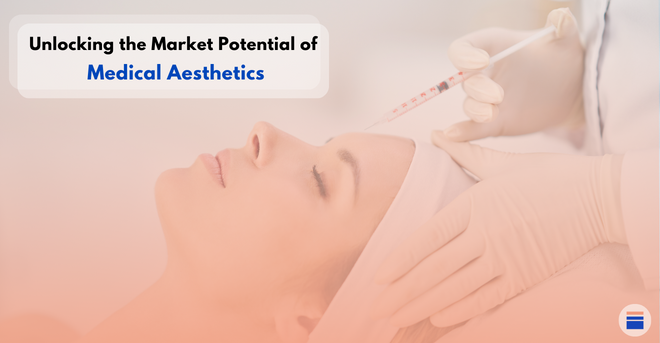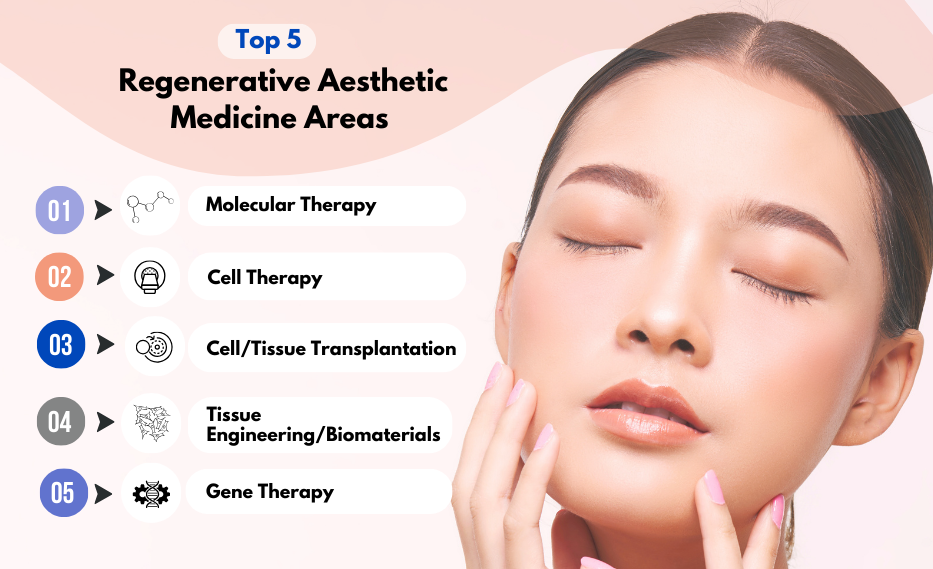Unlocking the Market Potential of Medical Aesthetics

| Table of contents |
| 1. The Current State of the Medical Aesthetics Market |
| 2. The Top 5 Trends in Medical Aesthetics |
| 3. Trends in Medical Aesthetics |
| 4. Regenerative Aesthetic Medicine: A New Frontier |
The medical aesthetics industry is an increasingly lucrative and rapidly developing sector of healthcare, currently valued at $13.9 billion and expected to reach a total of $23.4 billion by 2027. Despite this enticing profit potential, developers must consider the numerous challenges and emerging trends that will shape the future of this market.
The Current State of the Medical Aesthetics Market
The medical aesthetics market is presently dominated by North America and Europe with Asia-Pacific being the fastest-growing region due to increased demand from countries such as China, India, and South Korea. The second in speed of growth is Latin America. This growth has been largely attributed to a beauty and wellness revolution and an increase in disposable income coupled with a broader patient age range. According to the International Association for Physicians in Aesthetic Medicine advances in medical technology and procedures have increased the diversity of non-invasive procedures, which means that patients can enhance their appearance without the drawbacks and downtime of traditional surgeries.
The top challenge drug developers are currently facing is the management of clinical risks and complications:
- These risks emerge in the medical aesthetic space from inadequate, unskilled application of drugs and devices.
- Some of these drugs and devices are not coming from controlled and well-overseen manufacturers or through the right (legal and quality-controlled) channels.
Further industry-related challenges to consider:
- High development costs: Satisfying regulations necessitates expensive clinical trials and other testing procedures to prove the safety and effectiveness of drugs and medical devices to regulatory agencies.
- Long approval processes: The process to reach regulatory approval is multi-phased and can take many years.
- Short product lifecycles: Due to technological advancement and fierce competition, many medical aesthetic products have limited shelf life and require frequent updating to remain competitive.
The Top 5 Trends in Medical Aesthetics

For drug developers, these trends offer a strategic opportunity which is critical in clinical trial design and implementation.
1. Increased awareness and accessibility
Over the last two decades, there has been a continual increase in awareness and adoption of medical aesthetics services and as more healthcare practitioners offer these services, they become more accessible. The increased accessibility of these procedures has not only made them more popular with different population segments but has also helped to improve the overall quality of life for many individuals.
2. Aesthetic procedures for different populations
Medical aesthetic patients are growing incredibly diverse, such generational groups includes millennials, geriatrics, and the male demographic. In fact, recent data suggests that nearly 50% of millennials and Gen-Z patients have received or would consider receiving medical aesthetic services. A large segment of these patients view medical aesthetic services as essential to their mental health and well-being.
3. Advanced technologies for less pain and more gain
A large consideration for drug development has become the user experience. Patients want user-friendly solutions that are easy to use, minimize downtime and come with increased safety and efficacy. These non-invasive and minimally invasive procedures have been on the forefront for most developers in recent years.
4. Home-use devices
The pandemic caused an increase in the number of in-office procedures. However, it also increased the use and development of home-use devices.
5. Elaborate treatment protocols and precision medicine:
More healthcare practitioners have begun to explore elaborate treatment protocols that are customized to the specific needs of patients. This customized approach aims to deliver better results than a one-size-fits-all treatment. Consequently, they are combining many procedures and treatments, presenting an opportunity for drug developers.
Trends in Medical Aesthetics
Top 5 minimally invasive procedures
- Neurotoxins
- Dermal Fillers
- Topical In-office Treatments
- Hair Removal
- Skin Tightening/Combination Laser
Top 5 surgical procedures
- Liposuction
- Breast Augmentation
- Abdominoplasty
- Mastopexy
- Blepharoplasty
Top 5 minimally invasive procedures as well as the top 5 surgical procedures are the ones which we are all very familiar because companies who are beside or behind these procedures are continually investing in this space and they are developing newer and more competitive solutions.
This list is not surprising. If we were to compare data from 5 or 10 years ago, some of the same elements are being represented: i.e., neurotoxins and dermal fillers on the minimally invasive side.
Regenerative Aesthetic Medicine: A New Frontier
An exciting newer topic within the medical aesthetic space is regenerative aesthetic medicine.
Top 5 regenerative aesthetic medicine areas or approaches that are being investigated
- Molecular Therapy
- Cell Therapy
- Cell/Tissue Transplantation
- Tissue Engineering/Biomaterials
- Gene Therapy

In the beginning there was a lot of concern about how this space would be regulated and the FDA responded with two guidance documents which should be followed by drug developers. One is related to standards in regenerative medicine that apply to the aesthetic space and the other is focusing on regulatory considerations for cell and tissue-based therapies and procedures. The EMA has also released guidance for advance therapy that regenerative aesthetic medicine developers should take into consideration.
As these treatments are gaining significant patient attention, investments in research and development will lead to more accurate, safe, and effective treatments that offer personalization for each patient.
This trend towards personalization is expected to revolutionize the way people approach medical aesthetics, ensuring treatments are tailored to address specific needs and conditions.
Contact Innovaderm Research to learn how we transform the dermatology field with our pioneering research and clinical trials.
Do not miss the chance to be at the forefront of innovation. Reach out to learn more about our CRO services and how your trial can contribute to shaping the future of dermatology.
About the Author:
Dr. Jasmina Jankicevic is globally recognized as a thought leader in dermatology & medical aesthetics drug/device development. She has led clinical development in dermatology and medical aesthetics for CROs, pharma/biotech, medical devices, and cosmetic companies. She has driven program strategy and implementation of 350+ clinical study protocols in 30+ indications while leading global cross-functional teams towards successful regulatory submissions, product launches, and innovative lifecycle management.
As a global expert in dermatology clinical development, Dr. Jankicevic has served as advisor to multiple companies on their way to global regulatory and commercial success of innovative therapeutic solutions for common and rare skin diseases, and aesthetic disorders.
Dr. Jankicevic holds Doctor of Medicine degree, Master of Medical Sciences degree, and Board-certification in Dermatology and Venereology from the University of Belgrade, Serbia. She is also a Certified Clinical Research Professional and a trained journalist. Dr. Jankicevic is a sought-after speaker, and author of numerous articles in peer-reviewed and trade journals.
Stay updated on the latest in the dermatology industry by subscribing to our newsletter. Do not miss out on valuable insights and research updates. Join our scientific community today.
Newsletter
Newsletter subscription resources

